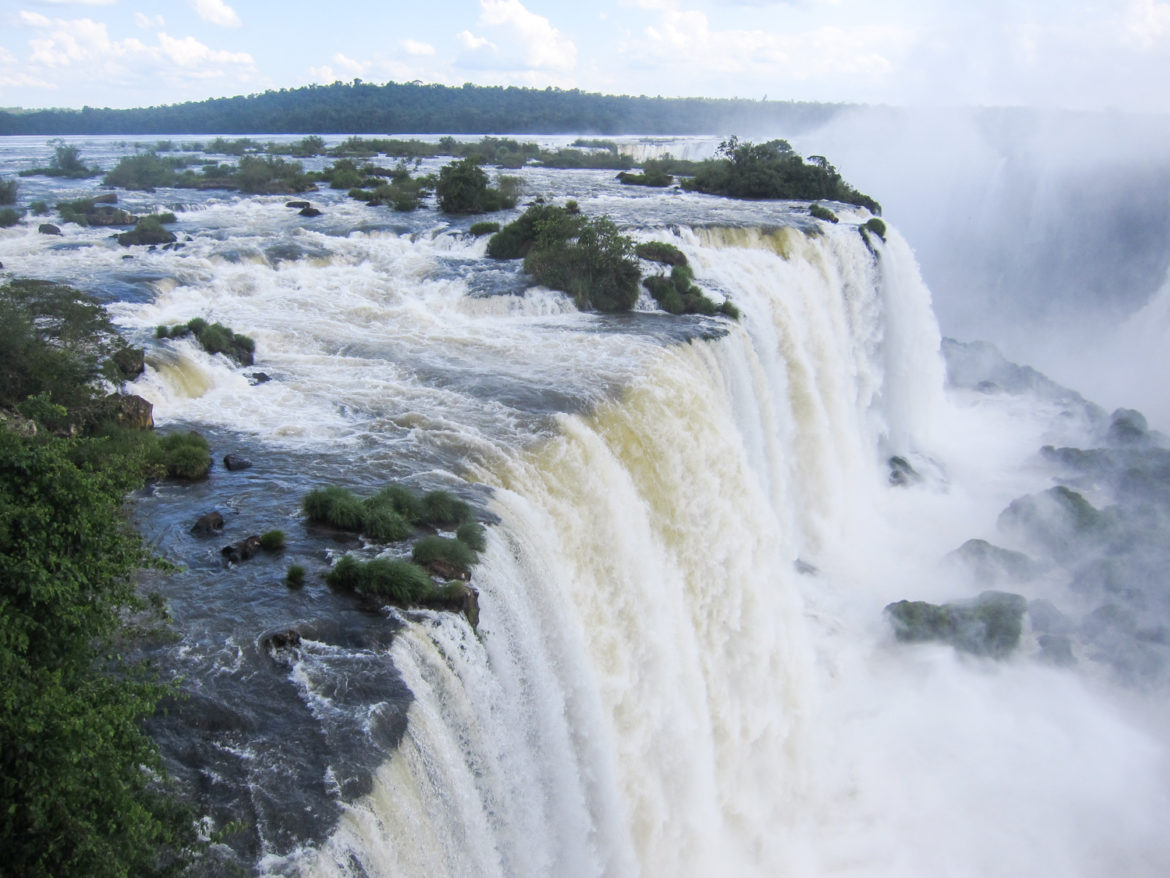Iguaçu Falls, which straddle both Argentina and Brazil, are among the world’s most spectacular waterfalls.
The falls were first discovered in 1542 by the Spanish explorer Alvar Nuñeç Cabeça de Vaca. In 1939, the area was designated Iguaçu National Park and eventually, a UNESCO World Natural Heritage Site.
From Montevideo (Uruguay) we took an overnight bus through Punta del Este, arriving in Porto Alegre (Brazil) in the morning. We spent a few hours sightseeing, then headed back to the bus station for a 20-hour bus ride to Foz do Iguaçu, the nearest Brazilian town to the falls. Needless to say, we arrived at Klein Hostel very weary and very in need of a shower. Thankfully, everyone was at the park so we we were able to catch up on our sleep in total silence. A different story that night but such is the life of budget backpackers…
After our power nap, we spent a relaxed afternoon exploring our tiny neighborhood. We discovered a corner mini market with plastic table and chairs set up outside that would become our nightly ritual – a true Cheap and Charming venue.
The next morning, we were well rested and ready to go for our first day in Iguaçu Falls.
We opted for the Argentinian side first and took a shuttle van to the park, arranged by our hostel for guests. On the van, we had a nice, laidback couple from New Zealand, an enthusiastic German student, another German couple currently living in Montevideo and two Austrian guys, one of which spoke fluent English… and Portuguese. Impressive.
After purchasing tickets, we headed for the entrance to the Circuito Superior (“Upper Circuit”) to get an elevated lay of the land. Entering the park, the scene reminded us of the movie, Avatar, a magical jungle with surprises around every corner and a variety of wildlife. The park contains a rich biodiversity of fauna and flora including butterflies, birds, giant lizards – even jaguars!
One of the more interesting animals we saw was the Coati, a typical Brazilian forest-dwelling animal.
Similar to a raccoon, but with a long pointed nose, these creatures have become very familiar with tourists. So much that they can often be quite aggressive. Best not to feed or encourage these small scavengers, unless you want to be harassed for your entire visit.
We enjoyed our time walking through the winding pathways, stopping at several viewpoints to watch the rushing waters. It’s amazing to sit for a few moments and take in the lush, natural beauty. Everything feels so alive. Even with all the tourists, the park felt peaceful.
After a picnic lunch (keeping an eye out for cheeky coatis), we strolled the Circuito Inferior (“Lower Circuit”).
This path took us up close and personal to the falls. From a distance, the waterfalls appear serene – only when you’re a few feet away do you realize the magnitude of their power. A couple of walkways lead out under the gushing falls where we got drenched in a matter of seconds. It’s a thrilling thing to experience – and witness – how falling water makes visitors instantly giddy.
Iguaçu Falls is made up of nearly 300 waterfalls and we saved the best for last: Garganta del Diablo (“Devil’s Throat.”) We could feel the anticipation building as we made our way across the long metal catwalk over surprisingly calm waters. Once we reached the viewpoint, the crowds bottlenecked as everyone clamored to take pictures of the U-shaped chasm. When we finally found an opening, we slid in and looked down – wow.
Devil’s Throat features 14 expansive falls in a “curtain” that plunges more than 350 feet.
Indeed, the scene is incredible as we were literally standing over the edge of the falls. Approximately half of the Iguaçu River’s flow makes its way into Devil’s Throat. The spray of the falls is so forceful, it’s impossible to stay dry. And the mist is so thick, it’s difficult to see the pool below. Instead, we were treated to a stunning rainbow, which we imagine is quite common given Brazil’s abundant sunshine.
After our first day in Iguaçu Falls, it’s understandable why, upon seeing the park for the first time, U.S. First Lady Eleanor Roosevelt famously exclaimed, “Poor Niagara!”
The next day, we visited the Brazilian side of Iguaçu Falls, known for classic panoramic views.
The Argentinean side contains up to 80% of the falls so it’s hard to get a sense of the scale by being so close to them. From the Brazilian side, we were able to see everything from a distance. It’s truly remarkable to observe the abundance of waterfalls and how expansive the scene is in its entirety.
If we’d only had one day here, it would be difficult to choose which side to visit. Both offered unique experiences with different vantage points. On the Argentinean side, we loved the long nature trails and catwalks. Devil’s Throat was definitely a highlight. On the Brazilian side, while the pathways were shorter, there seemed to be less crowds. Again, being able to see all of the falls from a distance was impressive and helped us better understand the size and scope. We were most grateful for gorgeous weather on both days.
On our last night, after relaxing by the pool at the hostel, we headed out to join the locals at the mini market on the corner. We split a 1 Liter of ice cold Brahma beer (served in its own huge koozie!), along with a bacon cheeseburger and chicken empanada. When the owner saw us for the third night in a row, his face lit up. Smiling, he gave us a thumbs up – a small form of communication that said so much.

